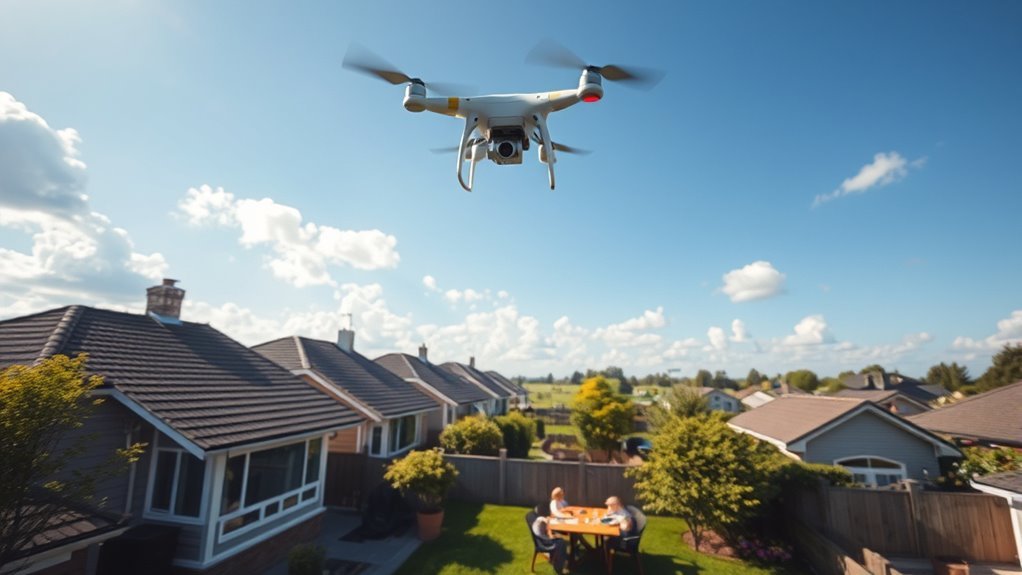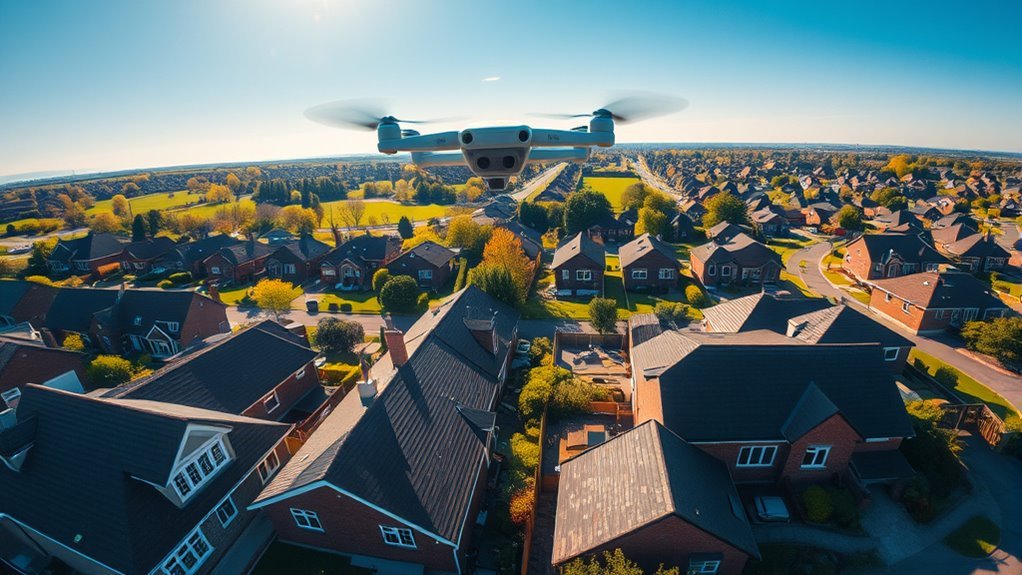To legally fly your drone over houses, first confirm you’re compliant with local drone regulations and have registered your drone with the appropriate authorities. Always obtain necessary permits or homeowner permissions, respect privacy laws by avoiding intrusive camera use, and maintain safe distances from people and buildings. Keep your drone within visual line of sight, steer clear of no-fly zones, and follow altitude limits to confirm safety. Understanding these key steps will help you operate responsibly and avoid legal issues.
Understanding Local Drone Regulations

Before you fly a drone over houses, you need to understand the local regulations that govern such activity. Drone laws vary greatly by jurisdiction, so you must familiarize yourself with the specific rules in your area. Importantly, airspace classification determines where you’re allowed to operate your drone. For instance, certain classes restrict drone flights near residential zones, airports, or controlled airspace. Ignoring these classifications risks legal penalties and endangers others. You need to check for any temporary flight restrictions or no-fly zones before each flight. By respecting drone laws and airspace classification, you not only guarantee compliance but also preserve your freedom to fly safely and responsibly over houses. Mastering these rules is your first step to confidently enjoying drone operations without interruptions or legal issues.
Registering Your Drone With Authorities

Before flying your drone over houses, you’ll need to complete the registration process with the relevant authorities. This typically requires submitting specific documentation, such as proof of identity and drone details. Ensuring your registration is accurate and up to date is essential to comply with legal requirements.
Registration Process Overview
Although flying a drone over residential areas offers unique perspectives, you must first register your drone with the appropriate authorities to comply with legal requirements. Understanding the registration process guarantees you maintain your freedom while respecting the law.
Here’s what you need to know:
- Identify your drone classification types to determine specific registration rules.
- Complete the online registration form accurately with your drone’s details.
- Pay the registration fees overview, which varies by drone weight and usage.
- Receive your registration number, which must be visibly marked on your drone.
Following this precise process protects you from penalties and keeps your flights lawful. Stay informed and proactive to enjoy your drone’s capabilities without restrictions.
Required Documentation
Two key documents you’ll need when registering your drone are proof of ownership and a valid government-issued ID. These verify your legal right to operate and establish your identity. Additionally, maintaining thorough flight logs is essential for accountability and compliance with local regulations. Some authorities also require proof of drone insurance, which protects you from liability in case of accidents. Before submitting your registration, verify all documents are current and accurately reflect your drone’s details. Failing to provide the correct paperwork can delay approval or result in penalties. By preparing these documents meticulously, you safeguard your freedom to fly while respecting legal frameworks designed to keep neighborhoods safe. Stay organized, and keep digital copies handy for quick access whenever you take your drone airborne over houses.
Obtaining Necessary Permits and Permissions

Since flying a drone over residential areas involves privacy and safety concerns, you need to secure the proper permits and permissions to operate legally. Understanding the permits process and permissions requirements is essential to avoid fines or legal issues. Here’s what you must focus on:
- Verify local and federal regulations governing drone flights in residential zones.
- Apply for any necessary flight waivers or authorizations through aviation authorities.
- Obtain homeowner or property owner consent when required by jurisdiction.
- Guarantee compliance with any time, altitude, or flight path restrictions tied to your permits.
Respecting Privacy Laws and Property Rights
Securing permits and permissions is just one aspect of responsible drone operation over residential areas. You must also respect privacy laws and property rights to avoid legal issues and maintain trust. Privacy concerns arise when your drone crosses property boundaries or captures images without consent. Always stay within public airspace or obtain explicit permission from property owners before flying overhead.
| Aspect | Requirement | Benefit |
|---|---|---|
| Privacy Concerns | Avoid capturing private activities | Prevent legal complaints |
| Property Boundaries | Stay within allowed airspace | Respect landowners’ rights |
| Consent | Obtain if flying over private land | Maintain goodwill and freedom |
Maintaining Safe Distances From People and Structures
Although flying over houses requires careful attention to privacy laws, maintaining safe distances from people and structures is equally critical to guarantee safety and prevent accidents. You must always keep your drone at a safe altitude and manage drone proximity carefully to avoid collisions and disruptions.
Flying safely over houses means respecting privacy and keeping a safe distance from people and structures.
To maintain safety, focus on these key practices:
- Keep a minimum horizontal distance of 30 feet from people and buildings.
- Avoid flying directly over crowds or occupied spaces.
- Monitor your drone’s altitude, ensuring it’s high enough to be safe but within legal limits.
- Be vigilant about obstacles like power lines, trees, and antennas.
Flying Within Visual Line of Sight
When you fly a drone, keeping it within your visual line of sight is essential for maintaining control and ensuring safety. This means you must always be able to see your drone unaided by any device other than corrective lenses. Employ effective visual observation techniques by positioning yourself where you have a clear, unobstructed view, avoiding distractions, and scanning the sky regularly. Maintaining line of sight prevents collisions and helps you react quickly to unexpected obstacles or changes in flight conditions. Relying on first-person view (FPV) alone isn’t sufficient; your direct vision is the legal and practical standard. By mastering these observation techniques, you gain the freedom to confidently navigate your drone over houses while adhering strictly to regulatory requirements and minimizing risks.
Avoiding No-Fly Zones and Restricted Airspace
Because flying a drone over houses often brings you close to sensitive locations, you need to be vigilant about avoiding no-fly zones and restricted airspace. Use updated no fly maps to identify prohibited areas before every flight. Understand airspace classifications—Class B, C, D, and E airspace often have specific restrictions requiring authorization. Always check Temporary Flight Restrictions (TFRs) that can pop up suddenly. Here’s how to stay compliant:Stay alert to no-fly zones, airspace rules, and temporary restrictions for safe drone flights over homes.
- Consult official no fly maps regularly to spot restricted zones.
- Learn airspace classifications to know where drone flights are limited.
- Obtain necessary permissions for controlled airspace near residential areas.
- Monitor NOTAMs and TFRs for temporary restrictions impacting your flight.
Best Practices for Minimizing Noise and Disturbance
To minimize noise and disturbance when flying over houses, you should select quiet flight modes designed to reduce drone sound output. Always maintain a respectful distance from private property to avoid intruding on residents’ privacy and personal space. These practices help guarantee your drone operation is both considerate and compliant with local expectations.
Choose Quiet Flight Modes
Although drones inherently produce noise, selecting the quietest flight modes can greatly reduce disturbance to residents below. You can harness stealth modes designed for noise reduction, allowing you to enjoy your freedom without drawing unwanted attention. Prioritize these settings to minimize sound impact while maintaining control and safety.
Consider the following when choosing quiet flight modes:
- Engage stealth or low-noise modes available on your drone model.
- Reduce rotor speed cautiously to lower noise without compromising stability.
- Fly at higher altitudes where noise disperses more effectively.
- Opt for flight paths over less populated areas when possible.
Respect Privacy and Space
Reducing noise is only part of flying a drone responsibly over residential areas; respecting the privacy and personal space of those below is equally important. You should always maintain a clear understanding of property boundaries to avoid intruding into private areas. Good drone etiquette requires you to keep your drone at a respectful altitude and distance, minimizing any disturbance or sense of surveillance. Avoid hovering directly over homes or backyards without explicit permission. Remember, your freedom to fly doesn’t override others’ rights to privacy. Use your drone’s camera thoughtfully, refraining from capturing images or videos where people expect privacy. By following these best practices, you guarantee your flight is both legal and ethical, fostering trust and freedom in the skies while preserving neighborhood peace.
Tips for Responsible and Ethical Drone Operation
While flying a drone over houses, you must prioritize respect for others’ privacy and safety. Responsible flying demands you understand and apply ethical considerations to maintain trust and avoid conflicts. Always guarantee your drone operation doesn’t intrude on private spaces or cause disturbances.
Key tips for responsible and ethical drone operation include:
- Obtain permission from property owners before flying close to homes
- Avoid capturing images or video that invade personal privacy
- Maintain visual line-of-sight and fly at safe altitudes to prevent accidents
- Comply with local laws and FAA regulations governing drone use

